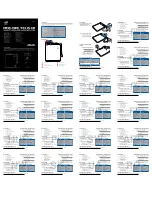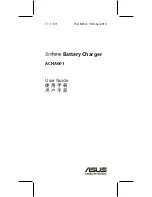
-
Protect the unit from damp.
-
Take care to ensure correct polarity at the output sockets.
-
Avoid short-circuits.
-
Do not subject the charger to direct sunshine. Do not
cover the unit when it is running.
-
Do not attempt to recharge a NC pack which is already
hot. Allow packs to cool down to ambient temperature
first.
-
The charger can become very hot during the discharge
process. Allow it to cool down again before touching it.
-
Use only NC packs which are stated to be capable of
rapid-charging. Cells in a pack must be balanced (equal
state of charge).
-
Packs must consist of NC cells of the same capacity,
make and type.
-
Do not charge two batteries in parallel.
-
Keep to the battery manufacturer’s recommendations.
-
Suitable only for charging rechargeable batteries.
-
Adjust the charge current so that it does not exceed the
maximum load of the cable and connector atached to the
battery.
IEC interference suppression
Before you use the charger the charge lead must be modified
by passing it through the ferrite ring supplied, as shown in the
sketch below. This ensures that the charger meets IEC sup-
pression regulations.
robbe Modellsport GmbH & Co. KG
We reserve the right to alter technical specifications.
Operating instructions
POWER PEAK PLUG &CHARGE
Order No.
8379
10
Notes
The trickle charge process ensures that the capacity charged
into the pack during the rapid-charge process is maintained
until the battery is used.
The maximum charge and discharge currents vary according
to the number of cells in the pack.
Never terminate the charge or discharge cycle by discon-
necting the battery.
All error messages remain on the screen for about three sec-
onds after you have cancelled them.
If you encounter problems with automatic current setting
when using fairly old batteries, we recommend that you
charge them using the manual current setting facility.
If you find that you cannot select a current, this means that
the charger is about to terminate the process.
Please note the following points before you attempt to
charge a transmitter battery:
You will need to by-pass the reverse polarity diode in the
transmitter’s charge circuit, or disconnect the battery from the
transmitter and use a direct charge lead.
Most transmitters are now fitted with this reverse polarity
guard diode. If no method of by-passing it is fitted, have the
modification carried out by a specialist, or - even better - by
the robbe Service Department.
Charging a transmitter battery with the reverse polarity diode
in circuit will cause the charger to terminate the process
early, and may result in permanent damage to the battery
and/or the charger.
-
Direct charge leads:
No. 8262
F-series transmitters
No. 8263
International series
Safety notes
-
Disconnect the charger from the power source if it is not
to be used for a long period. Disconnect any NC packs
from it at the same time.
-
Set up the unit on a hard surface (not carpet or felt)
before using it, so that its cooling slots are unobstructed
for good air circulation.
-
Do not place the charger or batteries on a flammable sur-
face when in use, and never leave the charger running
unsupervised.
































